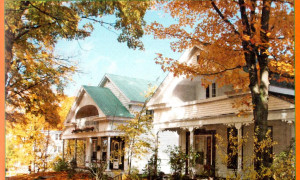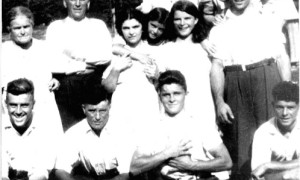Articles
Keziah Jaquith, Daniel Way’s future wife, was born on November 16, 1793. She was the second daughter of Jesse Jaquith and Keziah Hathorn. Jesse Jaquith’s ancestry can easily be traced back all the way to Richard Jaques, a French protestant, or ‘Huguenot’. Richard’s son, Abraham, born around 1610, settled in the Massachussets Bay Colony.
We’ll catch up with the Gustins, Macks and Millers near the U.S.-Canada border later. For now, their nephew Daniel Way, born in 1794, is growing up in Marlow, Cheshire County, NH. The town has voted six months’ schooling for all children in 1792 and since then several district schools have been built.
The Way family thus came in 1787 to the area of Marlow, Cheshire County, New Hampshire, joining some 200 souls just recently settled there. Have a look on a map…Marlow lies some 260 km North of Lyme, Connecticut…and 270 km South-East of Stanstead…Halfway… The area is beautiful.
We know that Way’s Mills was founded in the mid-19th century by Daniel Way, who is buried in Way’s Mills cemetery, up on Jordan Rd. His son, L.S. Way, followed in the footsteps of his father and operated for over half a century the woolen mill that once stood by the Niger River at the entrance of Way’s Mills.
Taproot IV: Poetry, Prose, and Images from the Eastern Townships, the latest edition of a series of anthologies published by Townshippers’ Association, has just been released.
"From Ottawa or Washington this international community is something that can not possibly exist officially. But it does still exist at the community and personal level. Our fire departments […] stand ready at all times to assist one another. Our churches and service clubs see no border when someone is in need.
“My father bought that gatherin’ tub in 1919, the year he started sugarin’. It was made by a fella name of Odd Aldridge over here in Moe’s River. He was a cooper – made washtubs, barrels, buckets… I tell ya I wouldn’t mind havin’ all the nickels and pennies worth of sap that’s gone through that tub.”
Derek Booth has just released his latest contribution to Quebec’s railway and transportation history. Quebec Central Railway – From the St. Francis to the Chaudière is published by Railfare Books, and is the third volume in Booth’s series “Railways of Southern Quebec.”
Well known Townships writer and filmmaker Louise Abbott has teamed up with her partner Niels Jensen to produce what will certainly be considered a fine addition to any library of Eastern Townships source material.
A new publication, titled (in English) Cemeteries of Austin, is now available. Produced in pamphlet format, this 20-page fold-out brochure was researched and written by local historians Serge Wagner and Maurice Langlois, and was published in 2008 by the Austin Cultural Committee.
The one-room schoolhouse, so long the focus of folklore and nostalgia, is the subject of a new book. Days to Remember: One-room Schoolhouses in the Eastern Townships of Quebec, is the culmination of years of work by the Canadian Federation of University Women (CFUW), Sherbrooke & District.
The Eastern Townships : On Lake and River, by Matthew Farfan, is still available.
The historical development of the Outaouais has often found its origin in the Pontiac. It is within the Pontiac where the oldest traces of human artefacts were discovered, shortly after the retreat of the Champlain Sea. Archaeological discoveries found on Morrison Island revealed that the river in the Pontiac had become “the copper route”, starting from the Great Lakes and leading up to Eastern Quebec.
My Gaspesian roots come from my great grandmother Melvina Chedore Maskrey. She was born in 1865 at L'Anse Au Gascon to Alexander Chedore and Maria Flowers. I had never known anything about my Gaspesian roots until 1985 and I didn’t even know where the Gaspe was in Canada. I started doing genealogy twenty-seven years ago before the birth of my own child. Even though I never met my great grandmother I am proud to say that she had a connection to the Gaspe and I have met many wonderful people and I was able to visit that region of Canada.
Anyone with more than a passing interest in the architecture and history of the Eastern Townships, in particular that part of the Townships bordering the U.S., will be interested to know that a new book has just been published on a type of architecture that, apart from the neighbouring states of New England, is quite unique to this part of Quebec.
1. What two rivers meet at Matapedia near the head of Chaleur Bay?
2. Where did the first two permanent settlers in the Gaspé Bay area live?
3. What 3 rivers flow into Gaspé Bay?
4. What is the name of the town where Charles Robin first established his company headquarters?
5. What did the entire area surrounding New Carlisle become referred to legally?
6. Where was a Provincial Marine Biological Station and Fisheries School opened in 1948?
7. How long is the Cascapedia River?
1. The Matapedia and the Restigouche
2. Sunny Bank and Peninsula
3. The Dartmouth, the York and the St. John
4. Paspebiac
5. The Township of Cox
6. Grande-Rivière
7. About 75 miles
8. Mount Jacques Cartier in the Parc de la Gaspésie
9. Carleton
10. The Cascapedia Hotel
1) How did Lachute get its name?
a) The town is named after Edmond La Chute who established a mill there in 1802.
b) The town is named after a local waterfall.
c) Lachute is a corruption of “The Shoot,” which referred to an annual hunt that took place here in the 1800s.
d) Lachute is a corruption of the Indigenous word Lac’heutkt’ewah, which translates roughly as “good fishing place.”
1) b) La Chute is French for "the waterfall."
2) a)
3) a)
4) c) Jericho, Vermont.
5) a)
6) c)
7) b) The Argenteuil Agricultural Society, founded in 1826, has held an annual exposition ever since. The first Argenteuil County fair was held in St. Andrews East in 1826. For the next fifty years, different towns hosted the event. Since 1877, the fair has been held in Lachute.
8) a)
9) b)
10) b) These are the falls of the North River.
Compassionate Return
“Compassionate leave to Canada will only be granted in very exceptional cases in which extreme hardship would be caused to the individual concerned or his dependants, if he did not return. It must be demonstrated that the hardship could not be alleviated in any other manner.”

